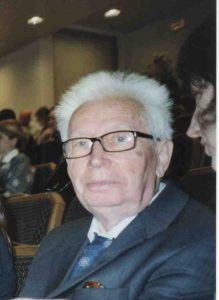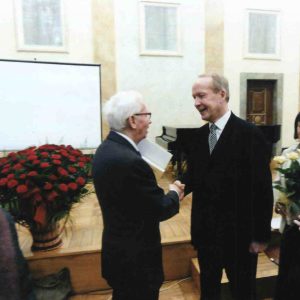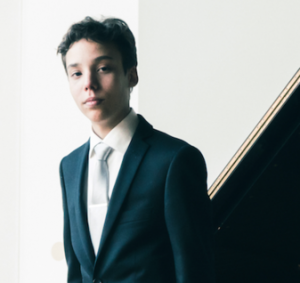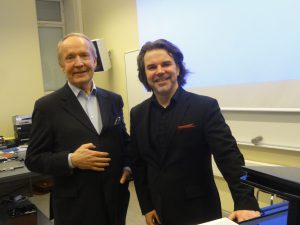
Tomaszewski in Vilnius at a Musical Signification congress in 2008
Mieczysław Tomaszewski, 1921-2019, Professor of Music History, Cracow Music Academy
It was hard to believe the message of his passing away since we were all accustomed with the thought that may all other things perish Tomaszewski is there, teaches, speaks, writes, publishes for all generations. He was an ideal and idol of a European music master, something which Hermann Hesse portrayed in his Glasperlenspiel. He was the embodiment of many issues in music and cultural history. I remember having heard about him from his colleague, piano professor Jan Hoffman from the Cracow Music Academy, as early as 1973 and 1974 when he was giving masterclasses in Helsinki, which I attended. He told they had in Cracow a circle or club which had regularly gathered after the war for discussions about music, culture, philosophy. Then I learned to know him during my many visits to Cracow and when we arranged a Polish music symposium in Helsinki with Tomaszewski, Bristiger, Steszewski, Chlopicka, Malecka and many others.
He knew the whole European culture and art history from inside. When you read his books and texts you notice that they are full of references to the most central literary figures of our tradition from all periods. I remember when I once studied the Polish symbolist poet Przybyszewski due his short treatise: Chopin und Nietzsche, Zur Psychologie eines Individuums (because Jean Sibelius had read it and dedicated a copy to his friend pianist Adolf Paul); I mentioned this to Tomaszewski, and he answered: he was my grand-uncle! In his later years Tomaszewski became interested in semiotics, being comparable to the Swedish musicologist Ingmar Bengtsson who also adopted semiotic view for his extensive monograph Musikvetenskap (1973). Yet, Tomaszewski understood the narratologic studies of Chopin and regularly attended the congresses of the Musical Signification project all over Europe until recent years: Vilnius, Cracow, Cambridge, London, Louvain, Brussels… He was the chair of the Cracow Congress in 2012 which figures as one of the most perfectly arranged conventions in the history of the project.
We may easily identify Tomaszewski as a typical Polish scholar due to his remarkable and distinguished study on Chopin (1999), probably the most important and all encompassing monograph on the composer’s life and work. However, he was also active in the Beethoven festivals in Warsaw which Elzvieta Penderecki started to organize some twenty years ago. Tomaszewski had within this festival his own international symposium on various aspects of Beethoven’s output. By this he wanted to show that just like Chopin is a universal figure, so Beethoven likewise belongs to all nations. He wrote to me and invited me for the 6th Ludwig van Beethoven Easter Festival (“Beethoven – Schubert – Chopin. The quest for the expression of one’s existence. The relationship between art and life”) in March 2002. The following year he wrote again and invited me to the same event dealing with the great musical tradition preceding the era of Beethoven: Beethoven and the Musical Tradition of the Baroque. Moreover, I remember that as early as 2001 he had invited me to a academic symposium on “Beethoven and the Music of the 20th Century, ‘Century of Apocalypse and Hope’”; I mention these because the titles and topics are so characteristic of Tomaszewski’s broad humanist interests in music.
Nevertheless, with his incredible erudition he also had philosophical aspirations and in this sense organized in Cracow a major symposium on transcendental values such as beauty and truth in music. I can’t believe that any other person would have had the courage in our time of postmodern knowledge and post-truth age to take such a theme as the topics of an international symposium. Having myself dedicated much time in these years to my own existential semiotics where such notion as transcedence plays a cogent role, it was delightful to see that there were other scholars as well interested in it. With my own theory which is still growing and becoming more elaborated, I often come to a situation in which I need to show that it pretends to be what A. J. Greimas called ‘englobant’, surrounding (the term, by the way, borrowed from Karl Jaspers, see Greimas: Sémantique structural, p. 226), whereas other approaches would prove to be ‘englobé’, surrounded. This may sound a little stubborn as an attitude but we know that progress in science, if any, oftentimes appears so that old theories are shown to be special cases withing a broader, more comprehensive intellectual framework. Without claiming that all could be just ‘reduced’ into existential semiotics, I next try to pursue such a mental experiment, with Tomaszewski’s general philosophical ideas on music and art history.
I also tried the same existential interpretation of his Chopin study and this essay has already appeared in the congress proceedings. In fact, I had also sent the following text in the occasion of is 90th birthday and I take the liberty to repeat it here now:
Il a été une joie particulière de faire votre connaissance il y a vingt ans je crois ; vos adorables ouvrages sur le maitre polonais (Chopin) nous ont ouvri … une vision authentique sur ses oeuvres au sein de la culture et l’histoire de Pologne. Mais en plus, vos activités infatiguables et pluridimensionelles sur l’esthétique et théorie musicale nous ont fait vous approcher, à savoir dans le sémiotique, ou vous vous figurez dans la grande tradition polonaise de la science des signes. Vos paroles et enthusiasmées et profondes sur la structure et sens des oeuvres musicales, leur création, vos modèls universaux sur la vie des compositeurs, sur les niveaux variés de ses oeuvres , votre connaissance de la culture musicale européenne de Beethoven à Penderecki – tout cela nous a donné un idéal à suivre, un but élevé à atteindre, une aspiration à réaliser. Tout par une admiration pour votre vie et vos avaux, votre créativité inépuisable.
Here I shall deal with some essays of Tomaszewski which can be considered characteristic of his writing and approach. At the 10th International Congress of the Musical Signification project, which was held at the Vilnius Music Academy on 21–25 October, 2008, Tomaszeweski delivered a speech Das Musikwerk in der intertextuellen Perspektive. Von der Inspiration bis zur Resonanz (published in Navickaitė-Martinelli 2010, p. 93–105). In general, you may allow me to make one note: his theories sound better in German than in English. He started from the observation that we live in a cultural space (Kulturraum) which constituted an intertextual space. Musical work does not emanate ex nihilo but from its cultural context. But in this space a musical work has its differentia specifica, and its interpretation is based upon inner relations in a work, but they are expanded into outer relations as well. In this context a musical work can be considered in its whole existence under three aspects: biographical, cultural and historical. The work is first determined by the biography of its creator. It is mirroring the concrete creative phase of the composer. Here one may remark, that Tomaszewski does not start discussing the theory generally accepted even by traditional musicologists like Carl Dahlhaus, who drew it from the Russian formalists, namely that the real author is to be distinguished from the so-called ‘implied’ author. Constantin Floros has certainly correctly noticed that in Gustav Mahler’s case the parallelism of life and music goes perhaps deeper and broader than one can magine. Yet, Dahlhaus once said in a congress on music philosophy (in Helsinki in 1986) that the hero of a Mahler symphony appearing by its themes is not the same as Mahler himself, (which the Finnish scholar Erik Tawaststjerna then immediately denied about Sibelius). Yet, Tomaszewski is certainly right in saying that there are certain traumatic experiences which a composer then tries to put within brackets, but often repeats them endlessly. This is the same as what Charles Mauron once stated in his psychocritic method based on the idea of obsessing myths which an author repeats, so that ultimately he writes only new work through his life. Tomasewski makes reference to such moments as Beethoven’s Heiligenstädter Testament from 1802 or Chopin’s diary from 1831. These are certainly existential moments in one’s life, Grenzsituationen, which have a decisive impact on creativity. It is what Heidegger and Jaspers called Scheitern, getting down, ruined. However, Tomaszewski proposes that such moments could be studied comparatively as narrative texts; thus he make a step towards a truly semiotic interpretation. He also calls such turning points as knot points of one’s life story – let it be like in the model of eines Heldenlebens by Jan de Vries or Vladimir Propp’s ‘functions’ in The Morphology of Russian Fairy Tale. Such points have their hierarchy, sure, but also their consecutive series. Yet, difference to a narratological analysis is here that those moments are seen like from inside the subject him/herself. In this respect, the Tomaszewski model could be paralleled with our ‘zemic’ asalysis. If in the existential semiotics the subject‘s mind is articulated via four phases following the semantic categories of Moi and Soi, i.e. body, person, profession or values (Moi1, Moi2, Soi2 and Soi1), then we might see that Tomaszewski’s six phases of the composer take place each within the temporal unfolding of each mode: so composer’s body, person, profession and value judgements pass through such a development almost like in a Goethean Bildungsroman. Tomaszewski’s knot points are like developments in one’s life story or ‘narrative’ and they are intimitely based upon his own experiences, Vorverständnis, preunderstanding and all his extensive cultural knowledge.

Tomaszewski’s 90th birthday party in Cracow in 2011 together with the author of this article (right).
The first moment is an assumption of heritage: each composer is born into a certain musical culture. He seldom decides himself that he will study music, instead he is made to study it – by his parents or educators. Therefore in order that later a great genius emerges the terrain must be prepared. There will be no Sibelius unless there is musical life, symphony orchestras and conservatories before him. There is no Chopin unless there is a centuries’ long tradition of Parisian salons kept by rich literary ladies. There is no Villa-Lobos in tropics either without the entrance of a European music culture centuries before. Next comes the first fascination i.e. our subject is excited, attracted, enthusiastic by some new phenomena. It is like love at first sight, so it is an encounter with Andersartigkeit, i.e. Otherness. The logical relation of difference instead of similitude. It is crystallization of the ideal. Romain Rolland portrays this in his novel Jean-Christophe. It is followed by a contradiction and resistance, a kind of Storm and Stress phase, it is a rebellion against restricted social, cultural, moral limitations. It is an effort to liberate oneself from overwhelming cultural conventions. So it is a romantic attitude, source of romantic irony, we might add. It is clear in Mahler’s saying Tradition ist schlamperei! Umberto Eco put it in the form that the aesthetic moment in a text is always based on its norm breaking. Thereafter comes the moment of meaningful meeting and it means the formation in ripe years of the work and its distinct personality, Communication is no longer mechanical transmission of a message but it becomes existential… It is followed by existential threat, it is a phase in which shadows appear in life, in the form of first health crisis (Sibelius: a tumor in throat, Chopin: lung disease); it is followed by doubts about one’s choice of one’s way. This is the memento point. At the end comes the deep sense of loneliness, and also freedom from phantasies of all previous limitations; it is the moment of separation, farewell, return to the past, and a glance at the future, re-enlivening of memories. almost like irrational.
There is no doubt that the generative course or path of a composer unfolds as a narrative arch of his life. It has an invariant nature like Tomaszewski puts it. So these six phases serve also as ‘punctuation’ criteria of one’s life they form life phases of a creator but also stylistic periods. So the beginning is just the assumption of a heritage, for instance composers write fugues, string quartets etc. in order to learn the profession. The early fascination means finding idols and models in other creators, like every Brahms work makes a reference to Beethoven, Ludwig Spohr was the mentor of Finnish Fredrik Pacius etc. The ripe phase constitutes the real personality of the composer, so what is truly ‘Beethovenian – Chopinian – Schubertian’. The climax, top point of one’s career is meeting with the other, and finding in a dialogue one’s identity; then comes the existential threat, a katharsis moment, this phase means turning from the autobiographical inspiration towards spiritual, pantheist, philosophical and sacred thematic. At the end comes the last, late creativity, deepening in oneself, separation from immediate reality; work adopts a soliloquial farewell character. Here come often mystical and metaphysical accents.
We could well see how these moments or phases could be situated in our zemic model as its particular articulations. Their weight seems to be different in diverse moments. One phase foregrounds aesthetic values i.e. the intelligible aspects (S1), the other one professionality (S2), still another one personality (M2). Thus we reach a highly qualified view on what happens in the story of composer’s life and this knowledge could be then applied a.o. to biographical studies. I am going to use in my Wagner monograph.
However, Tomaszewski is not only satisfied with making this diagram but notices also the manners whereby it can be transcended. Namely negativity i.e. negation can manifest as well as affirmation. A subject can be fixed with one knot refusing to pass into the following one. And this leads into false emphases of each case. Already Guido Adler stated that classical style and its balance of content and form can be fixed as academic style. So in Tomaszewski’s view fixation in the beginning phase leads into traditionalism, the stagnation in early phase into epigonentum in which models of the idols are only copies. The fixation into ripe phase leads to mannerism. It is amazing that fixation also can occur in the high point of one’s career leading to the academism. At the end the last phase overemphasized leads one to particular ascetism. Thus combining the Tomasewskian mythical model of our composer hero with the zemic model, we can develop it into an evaluative model where by we can judge different artistic phenomena.
Moreover, Tomaszewski distinguishes a cultural aspect of his paradigm and in order to scrutinize it he applies Roman Jakobson’s model of function in communication: so the emotive or expressive function – I have to correct a little his ideas also in some points – refers to composers’ or messages’ and one’s emotional state. Impressive or appellative function is in Jacobson conative i.e effort to have an impact on the listeners, task of every music work which fights for something. The referential function is not about transmission of messages but evokes the context where communication takes place. The messages and their codes belong to metalinguistic function. The phatic function is simply checking the physical channel – and not just a tendence to make sacred, spiritual or patriotic music. At the end comes the aesthetic or poetic function, where the form is autoriflessivo, Ohne Interesse, ohne Begriffe as Kant said, it is the musical work as such. The functional theory animated the Prague circle and was further elaborated of course by Jan Mukařovský.
Moreover, comes the historic aspect which manifests the inspiration phase, the contextuality and resonance phase. These equal in the existential theory to pre-signs, act-signs and post-signs. Yet, they can also be denied i.e. the tie with the past can be broken, the situation can be isolated, the future can be ignored. The musical work becomes a conceptual entity. In these ideas Tomaszewski comes close to Theodor Adorno’s Negative Dialectics after all. To conclude, Tomaszewski says, one needs all these issues, the fight between new and old as the spiritus movens in musical history. One could still specify this by noting that the central semiotic force could be in those two movements, one from the concrete and sensual to spiritual via sublimation and the other from the abstract, intelligible via embodiment to concrete and corporeal, i.e. between gegenständlich and ungegenständlich.
It is highly exciting that Tomaszewski organized in 2012 an international symposium on Music as a Message of Truth and Beauty. There he tackled one problem rather much neglected in the semiotic tradition namely that of values. The valid value theory in the contemporary mass media society living in the ‘extase of communications’ as Jean Baudrillard once put it, is based upon structural linguistic by Saussure in 1916; he said that no linguistic term had a value as such and per se, but only in relation to other terms, the continuum of other signs. It is the position of the sign which decides its value. Therefore, value is not an absolute entity but a relational unit. This ‘semiotic’ view was then expanded to the whole mass media society in which one thinks analogously that values are relative and decided by certain group of people against another group. Yet, there is another philosophical standpoint which postulates that values are universal, virtual and then actualized by some human agent and then realized in their mutual impact in a society. Roman Ingarden had such a theory. It is also the one in existential semiotics.
It is worth noticing that values in Tomaszewski’s view are in this latter category. That is not often presented in contemporary discussion, rather it shows a civil courage to think like that. It is as John Ruskin once said that he does not understand how opinions which are wrong as such would become true by merely the fact that many are supporting them. In his essay “Beauty and Truth, Imagination and Expression” Tomaszewski admits that when one tries to apply these transcendentals to works of art and to study them in reality, it raises questions and doubts. Plato speaks about ‘illusion’ and Tatarkiewicz about appearance. St. Augustine said: all is false in art, and with Goethe the very title of his Dichtung und Wahrheit reveals truth and falsehood. The whole avant-garde of the 20th century has declared transcendental values improper, inadequate and discreditable. One remembers Adorno who said there cannot be such issue in the post-Holocaust era. Yet, we cannot be satisfied with the distinction that only science deals with truth and arts beauty. Gustav Mahler remarked: Die Musik soll nicht schmücken, sie soll wahr sein (Malecka, Pawlowska 2014:13). And we know how for Marcel Proust the writer’s obligation was to reveal the truth. Roman Ingarden then emhasized that a work of art must have a faithfulness to the world view of its author, at least.
In our theoretical framework we might say that it must reflect and represent his zemic model. Maria Golaszewska, a great aesthetician from Cracow, emphasized in her essay on “Aesthetic culture” (1982) that art has to be blended to the whole of one’s life: “Art is a value which may first seem to be alien and unnecessary but when knowledge and experience grow and the aesthetic sensibility increases, it becomes an essential ingredience of one’s life and personality. This state is the highest stage of aesthetic culture”. This we could well interpret again in existential semiotic manner by observing the development of one’s zemic via its four modes of being. Moreover, Golaszewska a little bit like Tomaszewski distinguishes models of aesthetic attitudes: 1) respect for traditions, highest artistic achievements – see above Tomasewski’s idea of the heritage phase of an artist); 2) expression of a personality, i.e. authentic, spontaneous experience of the beauty: value is not so much the art work itself but our ability of Einfühlung, experience; 3) model of a complex aesthetic experience is typical of 20th century civilization. Yet, Tomaszewski sees the situation more dialectically as an opportunity of both affirmation and negation. The respect to values can appear either sincerely or insincerely, utruthfully. So we encounter four cases of artistic creation in our recent past: authentic art, musica vera like Gorecki’s Beatus vir or Penderecki’s Credo; 2) rhetorical art; 3) hyperbolic art, spontaneous homage to negative values, 4) panegyric art: musica falsa. This would be certainly what marxist theorists call falsches Bewusstsein in the art. Moreover, there is kitsch and Tomaszewski refers to Carl Dahlhaus. However, we know how difficult the notion of kitsch is as a concept of aesthetic judgment. For instance, Tchaikovsky’s andante theme for horn in the slow movement of his Fifth Symphony is kitsch for Dahlhaus. But it certainly represents authentic beauty for many sincere listeners.
Then in Tomaszewski’s essay appears the impact of technology in the form of music examples as sound tapes illustrating theoretical issues. This is a reference to the text as enunciation. His printed texts were originally written as conference speeches. So beauty and truth are best defined ostensively i.e. by showing: this music is beautiful, this is truhful. We can hear them from powerpoint directly. However, Tomaszewski adds here the categories of expression and imaginary to complete the picture.
There would be much to be said about Tomaszeweski as a Chopin scholar in which field he is an eminent and incomparable figure. But I have already commented in detail the Chopin interpretations of his book (1999) in my essay for the Chopin congress. There, I noted how the zemic model functions and explains many features in Chopin’s music.
Literature:
Maria Golaszewska 1982. “Esteettinen kulttuuri” (Aesthetic culture, translated from Polish into Finnish by Riitta Koivisto), Synteesi 1/82, 5-27.
Teresa Malecka and Malgorzata Pawlowska 2014. Music as a Message of Truth and Beauty. Cracow: Akademia Muzycznas w Krakowie.
Eero Tarasti 2012. Semiotics of Classical Music. How Mozart, Brahms and Wagner Talk To Us. Berlin: Mouton.
Eero Tarasti 2013. Sein und Schein. Explorations in Existential Semiotics. Berlin: Mouton.
Mieczysław Tomaszewski 1999. Frédéric Chopin und seine Zeit. Regensburg: Laaber.
Mieczysław Tomaszewski 2008. “Das Musikwerk in der intertextuellen Perspektive. Von der Inspiration bis zur Resonanz”. In: Lina Navickaitė- Martinelli (ed.) Before and After Music. Proceedings from the 10th International congress of the International Project on Musical Signification, Vilnius, 21-25 October. Acta semiotica fennica XXXVII. Lithuanian Academy of Music and Theastre, Vilnius; International Semiotics Institute, Imatra.
Mieczysław Tomaszewski 2014. “Beauty and Truth, Imagination and Expression” In: Malecka, Pawlowska ed., 2014:11-24.
– Eero Tarasti



